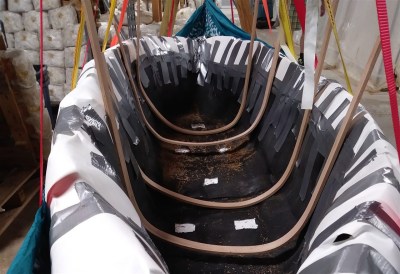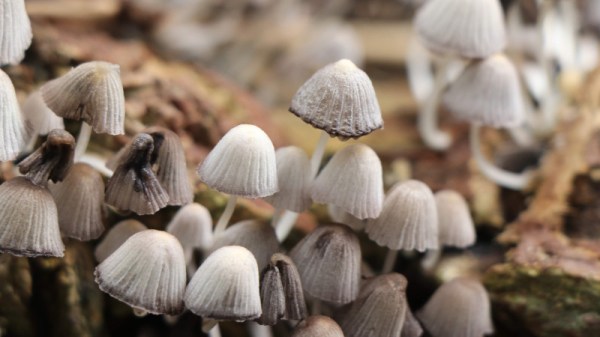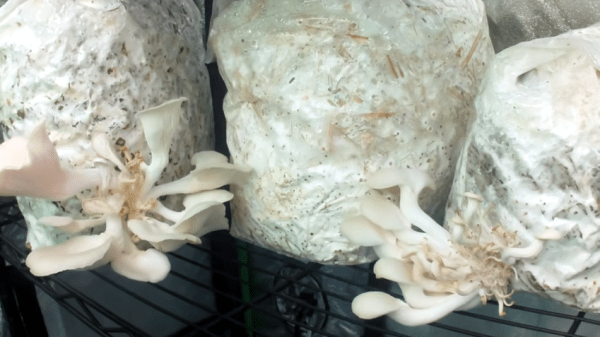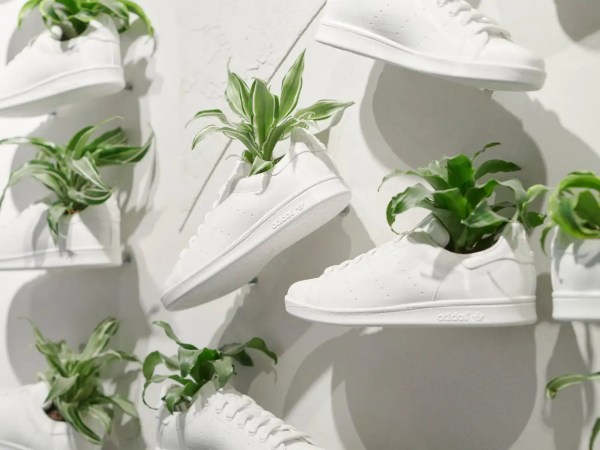A couple of weeks back, we covered an interesting method for prototyping PCBs using a modified CNC mill to 3D print solder onto a blank FR4 substrate. The video showing this process generated a lot of interest and no fewer than 20 tips to the Hackaday tips line, which continued to come in dribs and drabs this week. In a world where low-cost, fast-turn PCB fabs exist, the amount of effort that went into this method makes little sense, and readers certainly made that known in the comments section. Given that the blokes who pulled this off are gearheads with no hobby electronics background, it kind of made their approach a little more understandable, but it still left a ton of practical questions about how they pulled it off. And now a new video from the aptly named Bad Obsession Motorsports attempts to explain what went on behind the scenes.
mushrooms9 Articles
A Supercapacitor From Mushrooms
The supercapacitor is an extremely promising energy storage technology, and though they have yet to reach parity with the best batteries in terms of energy density, offers considerable promise for a future of safe and affordable energy storage. Perhaps best of all from our point of view, they are surprisingly simple to make. A practical supercapacitor can be made on the bench by almost anyone, as the ever-resourceful [Robert Murray-Smith] demonstrates using mushrooms as his feedstock.
The idea of a supercapacitor is to replace the flat plate on the simple capacitor from your physics textbook with one that has as large a surface area as possible for charge to accumulate on. In this case the surface is formed from organic charcoal, a substance which retains something of the microscopic structure of whatever it was made from. Mushrooms are a good feedstock, because their mycelium structure has a naturally huge surface area. He takes us in the video below the break through the process of carbonizing them, much easier when you have a handy kiln than trying the charcoal-burner method, and then grinds them to a powder before applying them as a paste with a binder to a piece of graphite foil. With two of these electrodes and a piece of paper towel as a dielectric, he demonstrates a simple benchtop supercapacitor running a small electric motor for a surprisingly longer time than we expected.
We’d like to see further work on home made supercapacitors, as we believe they have immense potential as well as storing the stuff. Meanwhile, this is by no means the most unexpected supercapacitor material we’ve seen.
Automated Mushroom Cultivation Yields Delicious Fried Goodies
[Kyle Gabriel] knows mushrooms, and his years of experience really shine through in his thorough documentation of an automated mushroom cultivation environment, created with off-the-shelf sensors and hardware as much as possible. The results speak for themselves, with some delicious fried oyster mushrooms to show for it!

The most influential conditions for mushroom cultivation are temperature, humidity, and CO2 concentration, and to automate handling the environmental conditions [Kyle] created Mycodo, an open-source system that leverages inexpensive hardware and parts while also having the ability to take regular photos to keep an eye on things.
Calling [Kyle]’s documentation “comprehensive” doesn’t do it justice, and he addresses everything from setting up a positive pressure air filtration system for a work area, to how to get usable cultures from foraged mushrooms, all the way through growth and harvesting. He even includes a delicious-looking recipe for fried mushrooms. It just doesn’t get more comprehensive than that.
We’ve seen [Kyle]’s earlier work before, and it’s fantastic to see the continued refinement. Check out a tour of the whole thing in the video embedded below (or skip to 16:11 if you want to make yourself hungry.)
Continue reading “Automated Mushroom Cultivation Yields Delicious Fried Goodies”
Hackaday Links: May 9, 2021
Well, that de-escalated quickly. It seems like no sooner than a paper was announced that purported to find photographic evidence of fungi growing on Mars, that the planetary science and exobiology community came down on it like a ton of bricks. As well they should — extraordinary claims require extraordinary evidence, and while the photos that were taken by Curiosity and Opportunity sure seem to show something that looks a lot like a terrestrial puffball fungus, there are a lot of other, more mundane ways to explain these formations. Add to the fact that the lead author of the Martian mushroom paper is a known crackpot who once sued NASA for running over fungi instead of investigating them; the putative shrooms later turned out to be rocks, of course. Luckily, we have a geobiology lab wandering around on Mars right now, so if there is or was life on Mars, we’ll probably find out about it. You know, with evidence.
If you’re a fan of dystopic visions of a future where bloodthirsty robots relentlessly hunt down the last few surviving humans, the news that the New York Police Department decided to stop using their “DigiDog” robot will be a bit of a downer. The move stems from outrage generated by politicians and citizens alike, who dreamt up all sorts of reasons why the NYPD shouldn’t be using this tool. And use it they apparently did — the original Boston Dynamics yellow showing through the many scuffs and dings in the NYPD blue paint job means this little critter has seen some stuff since it hit the streets in late 2020. And to think — that robot dog was only a few weeks away from filing its retirement papers.
Attention, Commodore fans based in Europe: the Commodore Users Europe event is coming soon. June 12, to be precise. As has become traditional, the event is virtual, but it’s free and they’re looking for presenters.
In a bid to continue the grand Big Tech tradition of knowing what’s best for everyone, Microsoft just announced that Calibri would no longer be the default font in Office products. And here’s the fun part: we all get to decide what the new default font will be, at least ostensibly. The font wonks at Microsoft have created five new fonts, and you can vote for your favorite on social media. The font designers all wax eloquent on their candidates, and there are somewhat stylized examples of each new font, but what’s lacking is a simple way to judge what each font would actually look like on a page of English text. Whatever happened to “The quick brown fox” or even a little bit of “Lorem ipsum”?
And finally, why are German ambulances — and apparently, German medics — covered in QR codes? Apparently, it’s a way to fight back against digital rubberneckers. The video below is in German, but the gist is clear: people love to stop and take pictures of accident scenes, and smartphones have made this worse, to the point that emergency personnel have trouble getting through to give aid. And that’s not to mention the invasion of privacy; very few accident victims are really at their best at that moment, and taking pictures of them is beyond rude. Oh, and it’s illegal, punishable by up to two years in jail. The idea with the QR codes is to pop up a website with a warning to the rubbernecker. Our German is a bit rusty, but we’re pretty sure that translates to, “Hey idiot, get back in your frigging car!” Feel free to correct us on that.
[Editor’s note: “Stop. Rubbernecking kills”.]
Adidas Going Natural With Mycelium Leather
Whether you are vegan or just want to try something new in the shoe department, Adidas will soon have your feet covered. They are currently working on a leather alternative made of mycelium, which is the network of fungal filament material that produces mushrooms, toadstools, truffles, and more. Hopefully they’re not using live mycelium, otherwise your shoes will grow mushrooms when they get wet like this mycelium canoe we saw a few weeks ago.
Adidas have really rooted themselves in sustainability over the past few years. They claim to have made 15 million pairs of shoes in 2020 out of recycled plastic waste collected from beaches and coastlines, and they’re shooting for 17 million pairs in 2021. The company started offering these in 2017, and they feature thread in the laces and other places that was spun from ocean plastic waste. Adidas are also using a lot of recycled polyester and are developing a new type of recycled cotton, according to Business Insider.
No use for mushroom shoes, canoes, or coffins (translated)? Everyone could probably use more insulation in their home. Why not grow your own?
Thanks to [Charles] for the mycelium coffin tip.
Mushroom Canoe Is Rooted In Nature
Mushrooms might be the most contested pizza topping after pineapple, but can you build a boat from pineapples? Probably not, but you can from mushrooms. Mushrooms, or rather their mycelium root systems, can be used for things like packaging, insulation, and furniture, and it could be the next thing in floatation, too. Just ask [Katy Ayers], a Nebraska college student who built an eight-foot canoe molded almost entirely of mycelium.
 [Katy] got into mushrooms when she was tasked with researching solutions to climate change. She loves to fish and has always wanted a boat, so when she found out that mycelium are naturally buoyant and waterproof, she decided to try using it as a building material.
[Katy] got into mushrooms when she was tasked with researching solutions to climate change. She loves to fish and has always wanted a boat, so when she found out that mycelium are naturally buoyant and waterproof, she decided to try using it as a building material.
[Katy] floated the idea by the owner of a local mushroom company and they got to work, building a frame suspended in the air by a hammock-like structure. Then they covered the boat’s skeleton with spores and let it proliferate in a hot, humid growing room. Two weeks later, they had a boat made of live mycelium, which means that every time it goes out on the water, it spawns mushrooms. The total cost including tools was around $500. The boat experiment spawned even more mycelium projects. [Katy] has since experimented with making lawn chairs and landscaping bricks from mycelium.
Don’t want to wait to grow your own mycelium boat? You can build one out of stretch wrap, packing tape, and tree branches.
Thanks for the tip, [ykr300]!
Main image by Katy Ayers via NBC News
Mycelia + Sawdust = House?
Take a guess. What is the featured picture for this article? If you’re channeling your inner Google image recognition, you might say: “Best guess for this image: rock.” But, like Google, you’d be wrong. Instead, what you see are bricks made out of fungi obtained from tissues of mycelia.
By taking fungi obtained from tissues of mycelia and storing them in a jar filled with a growth medium (usually sawdust), MycoWorks is creating all sorts of materials with exciting properties. In just three to seven days, the fungi and sawdust mixture expands and forms into clumps of material, which are then used to create products like handbags, purses, bricks, you name it. According to co-founder Phil Ross, “production of this material is similar to making ravioli from scratch, and the final product is more resilient than concrete.”
The resulting materials are buoyant, self-extinguishing and stress dissipating. Moreover, the bricks are alive up until they are put in a kiln. This means bricks that are placed next to each other will grow together, effectively enabling a structure to be made out of just brick, no mortar. And, while they’re not 3D printed, houses made in this fashion have great potential. If these cool new materials have got you excited, and you want to get cozy with the fungus among us, why not go all out with an automated mushroom cultivator?
Video after the break.
















